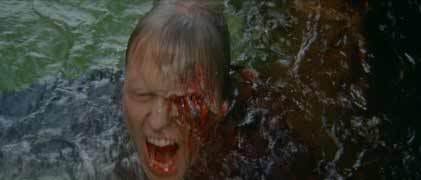April Fool's Day (1986)

Twist endings and the various resultant misdirection is a slippery slope in the movies.
When in works well, in films like M. Night Shyamalan's "The Sixth Sense" or "Unbreakable," the misdirection plays on our assumptions as moviegoers. We assume that a main character is alive, or that in a realistic world security guards aren't super heroes, so that when the big reveal is made, our enjoyment is that we were fooled, fairly, and we missed signs and clues that subsequent viewings will reveal (giving the films a rewatchability factor as well).
When it doesn't work, as in Shyamalan's "The Village" and in "April Fool's Day," it's because the filmmakers don't follow the rules. In the former, a headstone shown at the beginning of the film sets the time period as the 1800s. The subsequent reveal that our characters are part of a modern-day group of techno-/xenophobes, then, is a cheat. Why would they feel compelled to tell everyone it was 100 years earlier than it actually was?
In "Fool's," a group of pampered rich college kids who meet at the private island of Muffy St. John (Deborah Foreman) looking for fun on April Fool's Day. Most of them don't really know each other, but each represents several in the line of stereotypical horror movie teens: the randy, immature pranksters (Thomas F. Wilson of "Back to the Future," and Clayton Rohner), the quiet "good" kids (Amy Steel, Ken Olandt), the sexpot (Deborah Goodrich), and the backwoods nerd (Jay Baker).
The film starts off almost immediately with the pranksters playing a game of "stretch," where one of them flips a switchblade into the deck of their boat, while the other tries to reach it without taking a step. The game degenerates into one of them angrily flipping the knife at the other, so that it "stabs" him in the stomach. He falls into the water, and when the others go after him, both pranksters laugh. Turns out it was just a ruse, which would be impossible to convincingly pull off without the aid of camera cuts.
Much of the film is like that: a series of contrived, virtually impossible fakes of injuries impossible to do in real time or without someone else's knowledge. As each character is "killed off," the quickly-dwindling survivors wonder what to do. Phones are conveniently shut off, and since they're on an island, their only recourse is to swim, which probably isn't a good idea either.
Of course, when the endgame is revealed, the people who had been running for their lives react as if they'd been victimized by a whoopee cushion, playfully arm-punching their tormentors in "ha-ha, you got me" mode. Call me old fashioned, but if someone chases me with a knife, ax, hammer, or some other deadly weapon, prank or no they're getting punched in the face, and probably worse than that.
"April Fool's Day" was meant to be a twist on the "holiday horror" genre, though it's more akin to "Friday the 13th" than "Halloween" in style and substance (and if you're reading this site and don't know the difference, we need to talk). It's a really novel idea, but the utter lazy execution of the concept just left me wondering if the filmmakers were kidding.


